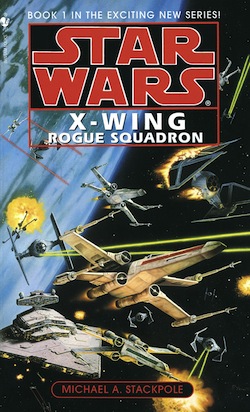When children played Star Wars in the late 1980s and throughout the 1990s it wasn’t as fun to pretend to be Luke Skywalker as you might think. By the end of the movies, Luke is kind of detached, to the point of being almost anti-social, and when you’re in a big gaggle of kids wishing you were in that galaxy far, far away, an easier, vaguer surrogate seems missing.
That is, until the secret lives of Rebel pilots opened up to fans via the games, comics, and novels. And Michael A. Stackpole nailed every little fan’s desire with the first X-Wing book, because after reading this, you didn’t really want to be Luke Skywalker; you would settle to just join Rogue Squadron.
To borrow a phrase; it turns out that the trick isn’t to restore freedom to the galaxy, but rather, keeping freedom in the galaxy through hard work. Enter the ragtag squadron of space fighter pilots who, it turns out, did the majority of the heavy lifting which resulted in stabilizing and creating the New Republic in the years between Return of the Jedi ending and Timothy Zahn’s Heir to the Empire beginning. While Luke meditated, Han and Leia bickered, and Lando (I guess) was busy souping up the Lady Lucky, Wedge Antilles had to assemble a team of crack-pilots who were willing to do the hard work of maybe getting killed by the remnants of the Empire. Rogue Squadron’s desperate, famous glory days might have been over, but maybe they were just and important as the larger-than-life-heroes. If there was any doubt as to the every-person themes Stackpole was going for here, you need look no further than the start of the book when Wedge tells newcomer Corran Horn that he’s good but he’s “no Luke Skywalker.”
Though Wedge Antilles is an important protagonist and leader in this first Rogue Squadron book, Stackpole makes an interesting choice of not making him the true central character. X-Wing: Rogue Squadron is so hardcore with its “what about the little guy?” message that even Wedge Antilles is relegated to a slightly paternal role. Corran Horn becomes the de facto reader surrogate, complete with angst, a chip on his shoulder, and something to prove. This works brilliantly for a young Star Wars fan, if only because it makes the Star Wars universe seem real in a petty sense. To put it another way: there’s actually things that aren’t only oppressive in a tyrannical way, but also, just plain annoying. Because if you lived in the Star Wars universe for real, the legend of Luke Skywalker would be kind of annoying.
But Rogue Squadron delights in other ways too, most of them a little bit more straight-forward. We get to hear Admiral Ackbar gurgle as he speaks, we experience how super-stressful it must be to fly a starfighter, and we get to worry, worry, worry about the basic logistical problems facing the still, kind of disorganized, Rebel Alliance. Michael Stackpole smartly split the difference in this book between introducing a cool ensemble of characters, and creating genuine exciting fan-service for those who simply could not get enough of the space battles from the films. Around this same time the X-Wing flight simulator game for the PC, which was as popular as it was difficult. Does this make this first X-Wing book a shameless tie-in to an already recognized brand at the time? Maybe, but honestly who cares? Stackpole invested in the established characters like Wedge and Ackbar with genuine love, while at the same time spinning all new intrigue and empathy for his new characters like Tchyo, Erisi, Oorly Qrygg, and of course, the newest-new-kid-on-the-block, Corran Horn.
Notably, the book Rogue Squadron was published in 1996 as part the X-Wing novel series. BUT, the comic series Rogue Squadron (also with Stackpole as a writer) was started one year before in 1995. What’s weird here is the crazy Rogue Squadron timeline a fan had to sort out to understand these different storylines. Now, this was the in the days before the interwebs gave us handy timelines of Star Wars chronology, so I seriously doubt most of the people reading the novels and comics had any clue how this all worked out. (I was 14, and I barely got it.) Here it is briefly: the comics are about an iteration of Rogue Squadron which existed in 4ABY (immediately after Return of the Jedi) while the novels deal with a new version of the group formed in 6ABY (like two years after Return of the Jedi)
Wait, you say! What the hell is Rogue Squadron? Well, it started as Red Squadron, which attacked the Death Star, and was subsequently lead by Luke throughout the timeline of the classic movies. (Which is about four years total.) Naturally, Luke did most of the leading of the group (save for the Battle of Hoth) completely off screen. Hence Wedge taking the reins in the comics, and then novels. Got it?
But honestly, you don’t need to know any of that to get into this first novel. It’s a fun reminder of how great the universe of Star Wars is, even when you’re not dealing with prophecies and star-crossed folks who don’t know they’re really related to each other. These days, the generation of children playing Star Wars tends to imagine the spinning of lightsabers or the barking of orders from Captain Rex to this battalion of Clone Troopers, but back in the 1996, it was all about being in the cockpit of a spaceship, fighting the scrappy leftovers of the Empire. With Rogue Squadron, Stackpole put all of us kids in our respective cockpits and made the Star Wars playground richer than it had ever been.
Up next in Wedge’s Gamble: I’ll talk more about the individual members of Rogue Squadron, all their drama with each other, and the most fun plotline of all: WHO’S THE SPY!???
Ryan Britt is a longtime contributor to Tor.com.










